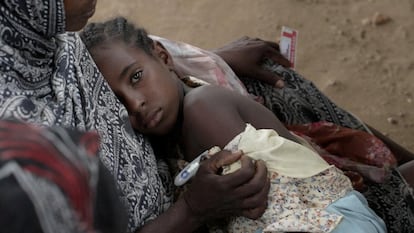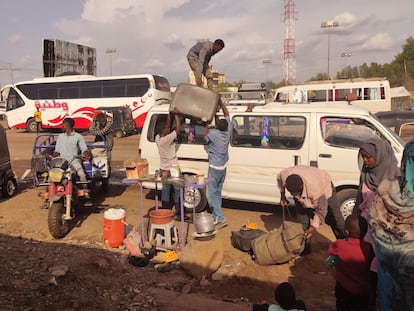After five months of war, Sudan has the highest number of internally displaced people in the world
The fighting that broke out in April, added to previous violence, especially in the Darfur region, has forced over seven million people to flee their homes

Just two weeks after war broke out in Sudan between the regular military, the Armed Forces of Sudan, and the paramilitary Rapid Support Forces (RSF) on April 15, the U.N. refugee agency (UNHCR) was already issuing warnings that the heavy fighting was forcing tens of thousands of people to flee their homes. After a month and a half of hostilities, the country had recorded more than 2.2 million internally displaced people, a figure similar to what had been documented over the previous 10 years due to a series of conflicts in Sudan. By mid-September, according to the International Organization for Migration (IOM), the figure exceeded four million people, just over 9% of the country’s population, an average of 26,500 people per day.
Almost 70% of refugees from the current war have fled the capital Khartoum, where much of the heaviest fighting has taken place, and the Darfur region (30%), according to the IOM.
In addition, some 3.8 million people had already been forced to leave their homes and migrate to safer regions of the country prior to April 2023 due to the violence that has plagued Sudan for years. Thus, UNHCR estimates that Sudan is currently the country with the highest number of internally displaced persons (IDPs) in the world, with more than seven million, ahead of other states ravaged by armed conflicts such as Ukraine and Syria. More than 1.2 million refugees have fled beyond Sudan’s borders.
Almost 70% of refugees from the current war have fled the capital Khartoum, where much of the heaviest fighting has taken place, and the Darfur region (30%), according to the IOM
Many of those who have fled their homes have done so with little more than the clothes on their backs, placing pressure on host communities where in many cases resources and access to basic services were already limited before the war. All of this has increased the humanitarian requirements in Sudan, where today an estimated 25 million people — over half the entire population — are in urgent need of assistance. “The influx of new IDPs in some parts of Sudan has overwhelmed public services and resources in the areas of arrival, especially in terms of shelter, health care, education and other services such as civil registration, water, energy and sanitation,” says Assadullah Nasrullah, UNHCR’s communications officer in the country.
Most of the IDPs registered in the country before 2023 were already taking refuge in areas subsequently affected by the war that broke out in April. As such, “some people could have been displaced for a second or a third time, which would result in a double count,” warns Clémentine André, coordinator for Africa and the Middle East at the Internal Displacement Monitoring Centre (IDMC).
Added to all this are the effects of the heavy rains and floods that have hit some regions of Sudan since July, affecting more than 70,000 people, especially in states in the north, center and west of the country. “The same people displaced by the war may have been displaced by the floods. Many families may have experienced multiple displacements in the last six months,” says André.
Before April, by far the worst-affected region was Darfur, where ex-dictator Omar al-Bashir launched a ferocious offensive and ethnic cleansing campaign in 2003 — carried out by many of the militias that today make up the Rapid Support Forces — with the aim of quelling an armed uprising against his repressive regime.
In 2008, the UN estimated that more than 300,000 people had been killed and 2.5 million displaced as a result of the violence, for which al-Bashir was indicted for war crimes, crimes against humanity and genocide by the International Criminal Court. Most of these displaced persons remained in camps in the Darfur region.
War, ethnic cleansing, and flooding
“In the areas where the displaced are sheltering, the prices of basic necessities and housing are skyrocketing,” says Arif Noor, the director of the NGO Save The Children in Sudan. “Before the escalation of violence, Sudan was already facing a severe economic crisis, which is now compounded as people flee their homes and lose their property, livelihoods, and access to land. The current displacement crisis is having a devastating effect on the population, especially children, who are increasingly exposed to risks such as child labor, early marriage, sexual exploitation, and recruitment by armed groups,” notes Noor, who adds the war is also “depriving children of access to education.”
UNHCR’s Nasrullah points out that there is also an increase in hunger. “The growing economic crisis has exacerbated food insecurity among both IDPs and their host communities.”
In parallel to the direct effects of the fighting between the Armed Forces of Sudan and the RSF, another major cause of the high number of new IDPs being recorded in Sudan is ethnic-based violence, including specific cleansing campaigns, that have been documented in Darfur since mid-April. Both the army and the police in the region have withdrawn from many areas to secure strategic installations, including military bases, creating large power vacuums that have been exploited by paramilitaries and like-minded militias to spread terror among people, mainly those from non-Arab tribes.
The current displacement crisis is having a devastating effect on the population, especially children, who are increasingly exposed to risks such as child labor, early marriage, sexual exploitation, and recruitment by armed groups”Arif Noor, director of Save The Children in Sudan
“The humanitarian and health situation in Darfur has become catastrophic,” says Adam Rojal, spokesman for a coordinator of displaced people and refugees in the region. “There are thousands of people who have taken refuge in areas controlled by Abdul Wahid al Nur’s Sudan Liberation Movement [in the Marrah Mountains of central Darfur] and in camps, and they are in need of basic emergency aid and services.”
Living conditions are particularly precarious in some of the camps hosting displaced people, especially for minors, who are particularly vulnerable. Between May and September, more than 1,200 children under the age of five died in camps in South Sudan’s White Nile State from what UNHCR called a fatal combination of malnutrition and a measles outbreak.

Insufficient humanitarian aid
The majority of internal displacement in Sudan last year was due to inter-communal tensions and violence in Blue Nile State in the south, and West Darfur. In both cases, the violence stemmed primarily from disputes over increasingly limited access to land and other resources.
“The big difference with the IDPs since April is that they have probably had to leave the place where they were living several times, and that the prospect of returning home or finding durable solutions in general is probably very remote,” says André.
Floods due to heavy rains, which usually occur between June and September and often cause rivers such as the Nile to overflow, have in recent decades been a recurrent cause of internal displacement. Between 2017 and 2021, these episodes affected on average 388,000 people per year, according to the humanitarian analysis platform ACAPS.
Despite this context, humanitarian aid agencies are encountering many difficulties in maintaining their activity in Sudan as a result not only of the war, but also due to bureaucratic and administrative obstacles, looting or attacks on humanitarian staff, and forced controls on supplies.
Added to all these issues is the lack of funding from the international community to meet the growing needs of the Sudanese population. To date, the UN has only been able to secure about 31% of the total funds it has requested to meet the country’s most urgent requirements.
Despite all these difficulties, UNHCR says it has been able to reach more than 400,000 IDPs so far in 2023, the vast majority of them since the war broke out in April, providing them with aid in the form of basic relief items, emergency shelter, cash assistance, or psychosocial and legal support.
From Darfur, however, Rojal warns that the aid that is arriving is not enough: “Citizens have reached the height of their suffering and are in dire need of protection mechanisms to be activated and avenues opened to deliver humanitarian aid, food, and medicine, after more than five months of war.”
Sign up for our weekly newsletter to get more English-language news coverage from EL PAÍS USA Edition
Tu suscripción se está usando en otro dispositivo
¿Quieres añadir otro usuario a tu suscripción?
Si continúas leyendo en este dispositivo, no se podrá leer en el otro.
FlechaTu suscripción se está usando en otro dispositivo y solo puedes acceder a EL PAÍS desde un dispositivo a la vez.
Si quieres compartir tu cuenta, cambia tu suscripción a la modalidad Premium, así podrás añadir otro usuario. Cada uno accederá con su propia cuenta de email, lo que os permitirá personalizar vuestra experiencia en EL PAÍS.
¿Tienes una suscripción de empresa? Accede aquí para contratar más cuentas.
En el caso de no saber quién está usando tu cuenta, te recomendamos cambiar tu contraseña aquí.
Si decides continuar compartiendo tu cuenta, este mensaje se mostrará en tu dispositivo y en el de la otra persona que está usando tu cuenta de forma indefinida, afectando a tu experiencia de lectura. Puedes consultar aquí los términos y condiciones de la suscripción digital.
More information
Archived In
Últimas noticias
Most viewed
- Sinaloa Cartel war is taking its toll on Los Chapitos
- Oona Chaplin: ‘I told James Cameron that I was living in a treehouse and starting a permaculture project with a friend’
- Reinhard Genzel, Nobel laureate in physics: ‘One-minute videos will never give you the truth’
- Why the price of coffee has skyrocketed: from Brazilian plantations to specialty coffee houses
- Silver prices are going crazy: This is what’s fueling the rally











































